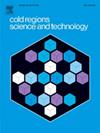Experimental study on shear behavior of geotextile encased lime energy column - soil interface in degraded permafrost environment
IF 3.8
2区 工程技术
Q1 ENGINEERING, CIVIL
引用次数: 0
Abstract
The differential settlement of warm permafrost foundations significantly impacts the safe operation of highway and railway embankments. The use of geotextile encased lime energy columns (GELECs) has been proven to be effective in pre-thawing shallow layers of warm permafrost as a novel method to reduce the post-construction settlement of embankments. Understanding the interaction between the GELECs and the soil is crucial in illustrating the load transfer mechanism. This study conducted a series of large-scale direct shear tests on GELEC-soil in degraded permafrost environments using an improved temperature-controlled direct shear test apparatus with assembled large shear boxes. The effects of different shear rates, water contents, and types of geotextiles on the mechanical behavior of the interface were analyzed. The strength development of the interface under various curing times was studied in detail. The experimental results indicate that the interface strength increases significantly during the initial stage of curing while the rate of strength increase diminishes over time. The improvement in peak shear strength is primarily attributed to the increase in interfacial cohesion, and the increasing trend of the cohesion follows an exponential decay function. And the microscopic strengthening mechanism of the interface was analyzed through SEM tests. Finally, a nonlinear elastic model incorporating a parameter to represent the variation of cohesion was developed to describe the shear stress-strain relationship at the GELEC-soil interface under different curing times.
土工布包覆石灰能柱-土界面在退化多年冻土环境下抗剪性能试验研究
暖冻土地基的差异沉降严重影响公路、铁路路堤的安全运行。使用土工布包裹石灰能量柱(GELECs)已被证明是一种有效的预解冻浅层温暖的永久冻土作为一种新的方法,以减少施工后的沉降路堤。了解geces与土壤之间的相互作用对于阐明荷载传递机制至关重要。本研究采用改进的温控直剪试验装置,装配大型剪切箱,对退化多年冻土环境下的gec -土进行了一系列大型直剪试验。分析了不同剪切速率、含水率和土工布种类对界面力学性能的影响。详细研究了不同固化时间下界面强度的变化规律。实验结果表明,在固化初期,界面强度显著增加,但随着时间的推移,强度增加的速率逐渐减小。峰值抗剪强度的提高主要是由于界面黏聚力的增加,黏聚力的增加趋势服从指数衰减函数。并通过SEM测试分析了界面的微观强化机理。最后,建立了以黏聚力变化为参数的非线性弹性模型,描述了不同养护时间下gec -土界面处的剪应力-应变关系。
本文章由计算机程序翻译,如有差异,请以英文原文为准。
求助全文
约1分钟内获得全文
求助全文
来源期刊

Cold Regions Science and Technology
工程技术-地球科学综合
CiteScore
7.40
自引率
12.20%
发文量
209
审稿时长
4.9 months
期刊介绍:
Cold Regions Science and Technology is an international journal dealing with the science and technical problems of cold environments in both the polar regions and more temperate locations. It includes fundamental aspects of cryospheric sciences which have applications for cold regions problems as well as engineering topics which relate to the cryosphere.
Emphasis is given to applied science with broad coverage of the physical and mechanical aspects of ice (including glaciers and sea ice), snow and snow avalanches, ice-water systems, ice-bonded soils and permafrost.
Relevant aspects of Earth science, materials science, offshore and river ice engineering are also of primary interest. These include icing of ships and structures as well as trafficability in cold environments. Technological advances for cold regions in research, development, and engineering practice are relevant to the journal. Theoretical papers must include a detailed discussion of the potential application of the theory to address cold regions problems. The journal serves a wide range of specialists, providing a medium for interdisciplinary communication and a convenient source of reference.
 求助内容:
求助内容: 应助结果提醒方式:
应助结果提醒方式:


